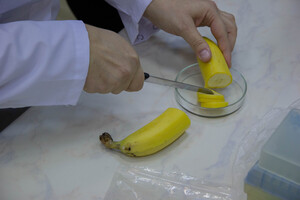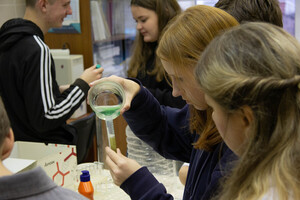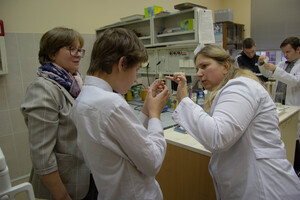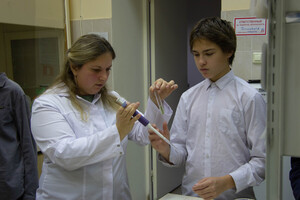How can a DNA molecule be isolated from a banana in a home experiment? Eighth-graders from Secondary General Education School No. 3 learned about it at a class in the Genetics Laboratory of the Institute of Biology KarRC RAS. The class was facilitated by Researcher Marina Zaretskaya and Research Trainee Daniil Atorin.
During the theoretical part of the class the children were reminded about the structure of DNA molecule and told about its role in biological processes, about what mutations can happen and what consequences they can have, what diseases they lead to.
In plants and animals, the DNA molecule is located in the cell nucleus. To “extract” DNA, a special solution must be prepared that destroys cell walls and nuclear membranes. As it turned out, this can be done with reagents you can find in any kitchen: table salt, baking soda and a dishwashing detergent.
Salt and soda are needed to prepare a solution with a certain stable concentration of hydrogen ions. It is supplemented with a detergent, a substance that reduces the surface tension of water for its better penetration into pores and between fibers. A dishwashing liquid can be used as a detergent. When added to the buffer solution, it destroys the cell membranes so that DNA strands float freely.
Mashed banana was mixed with the resulting solution and placed in a thermostat for 15 minutes at 60 degrees. At home, it is recommended to use a water bath. Next, filter paper or gauze can be used to filter out the destroyed cell walls. In the laboratory, a centrifuge is used for this purpose. White DNA strands visible to the eye in a test tube can be obtained after the precipitation process, which happens when ethyl alcohol is added.
— We chose this career-guidance tour to broaden our horizons on the subjects of biology and chemistry. We ran diagnostic tests at school, which revealed poor knowledge of natural science disciplines. In eighth grade children are just starting to learn chemistry and have had no experience with labware. It's curious to get acquainted with the work of the Genetics Laboratory, to see how the scientific equipment looks like. I think it was great practical experience and the class was beneficial! - shared Yana Sabantseva, tutor of the “Ticket to the Future” project at School No. 3, English teacher.
Classes under the “Ticket to the Future” project at KarRC RAS will continue until November 23. Participating in this project, schoolchildren can learn, first-hand, about the work of an analytical chemist, chemical analysis laboratory technician, geologist-mineralogist, and archaeologist. The group size is limited, pre-registration is required.
News
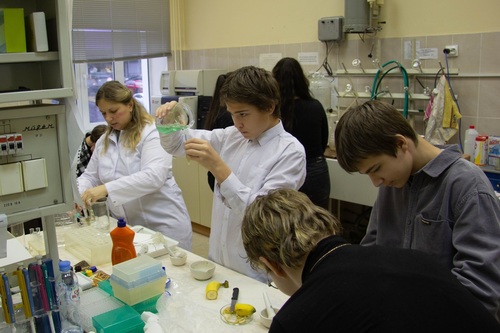
October 17, 2024
A new area for classes within the “Ticket to the Future” project was presented at KarRC RAS
Classes within the federal project “Ticket to the Future” started at the Karelian Research Center RAS. Participating in this project, schoolchildren can learn, first-hand, about the work of an analytical chemist, chemical analysis laboratory technician, geologist-mineralogist, and archaeologist. This year scientists present a new area of career guidance: familiarization with the work of a geneticist and molecular biologist. The first to attend a class were 8th grade students of Secondary General Education School No. 3 with Advanced Study of Foreign Languages in Petrozavodsk.
Classes within the federal project “Ticket to the Future” started at the Karelian Research Center RAS. Participating in this project, schoolchildren can learn, first-hand, about the work of an analytical chemist, chemical analysis laboratory technician, geologist-mineralogist, and archaeologist. This year scientists present a new area of career guidance: familiarization with the work of a geneticist and molecular biologist. The first to attend a class were 8th grade students of Secondary General Education School No. 3 with Advanced Study of Foreign Languages in Petrozavodsk.
See also:
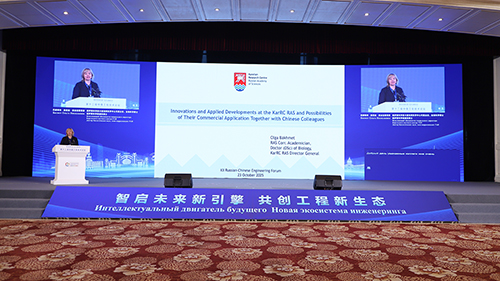
October 27, 2025
KarRC RAS Director General Olga Bakhmet presented practical developments by Karelian scientists at the 12th China-Russia Engineering and Technology Forum
KarRC RAS Director General Olga Bakhmet delivered a plenary talk at the 12th China-Russia Engineering and Technology Forum in the Chinese Harbin. The CEO presented our scientists’ developments in biotechnology, aquaculture, remote sensing, greenhouse gas monitoring, geology, and other fields, as well as announced the international environmental conference on the BRICS regional-level cooperation to take place in Petrozavodsk next year.
KarRC RAS Director General Olga Bakhmet delivered a plenary talk at the 12th China-Russia Engineering and Technology Forum in the Chinese Harbin. The CEO presented our scientists’ developments in biotechnology, aquaculture, remote sensing, greenhouse gas monitoring, geology, and other fields, as well as announced the international environmental conference on the BRICS regional-level cooperation to take place in Petrozavodsk next year.
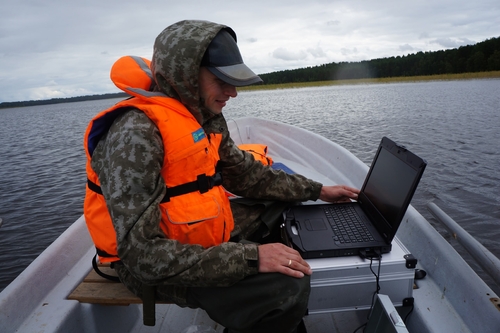
October 26, 2025
Scientists of KarRC RAS tested a new underwater acoustic system in freshwater bodies
A new underwater acoustic system was tested out in the field by specialists of the Laboratory of Fish and Aquatic Invertebrates Ecology, Institute of Biology KarRC RAS, during an expedition to Lake Syamozero in the summer 2025. The device was used to estimate the fish stocks, to determine the fish species composition, and to map the lake’s depths.
A new underwater acoustic system was tested out in the field by specialists of the Laboratory of Fish and Aquatic Invertebrates Ecology, Institute of Biology KarRC RAS, during an expedition to Lake Syamozero in the summer 2025. The device was used to estimate the fish stocks, to determine the fish species composition, and to map the lake’s depths.





